
Contents: Preface. 1. Introduction. 2. Early political connection of Nepal with India--Nepal under ancient Indian sovereigns and the local ruling dynasties of Indian origin. 3. Early movement of the Buddhists into Nepal, followed by the Hindus and the Jains-some evidences of social, religious, and cultural migration from India into Nepal. 4. Migration of people from India into Nepal and vice versa, and the growth of Indian and Nepalese population in the respective countries of adoption. 5. Conclusion--Agitation for a separate Gorkhaland for the Nepalese in India. Notes. Bibliography.
"The study recounts, as this title indicates, the story of migration between India and Nepal from the early Buddhists Age till the late 20 Century. If in the early Buddhist period Buddhist monks and Jain priests moved to the Himalayan Kingdom as a safe refuge with these books and manuscripts to escape the Muslim atrocities, the 20 century movement of other classes of the people of Indian origin was in the wake of the invitation of the Rana government of the Kingdom. The Indians who thus gradually moved from U.P., Bengal, Bihar and Rajasthan came to command the majority of Nepal’s population, while the hill tribes, the Sikhs, the Tibetans and the Bhutanese then living there constituted the minority. This migration from India was at once the movement of Indian people and that of Indian culture, religious thoughts and ideas. Such migration obviously led to the growth of Nepal’s population of an Indian origin. It was, as it were, a development leading to a unique kind of synthetic culture in Nepal like the cultural conquest of the Ancient Roman Empire by Hellenism.
A discussion on the recent agitation in Nepal for a separate Gorkhaland in the hill areas of Darjeeling under the leadership of Subash Gheising has been incorporated in the volume. The monograph, divided into five chapters, presents a new approach to the study of Nepal in relation to India." (jacket)